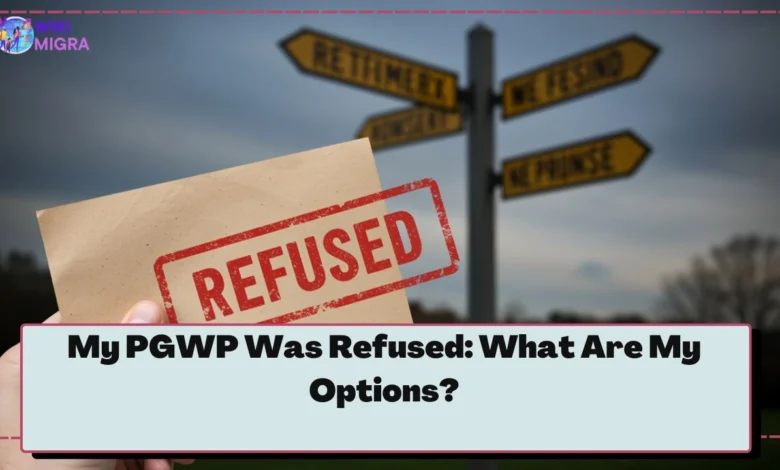My PGWP Was Refused: What Are My Options

If your Post-Graduation Work Permit (PGWP) application has been refused, there are several options and steps you can take to address the situation. Below is a detailed breakdown of what you can do, why refusals happen, and how to proceed effectively.
Step 1: Understand the Reason for Refusal
The first step after receiving a PGWP refusal is to carefully review the refusal letter issued by Immigration, Refugees and Citizenship Canada (IRCC). This letter will outline the specific reasons for the rejection. Common reasons include:
- Non-compliance with study permit conditions: For example, not maintaining full-time student status during your program (except in your final semester or during an approved leave).
- Ineligible program of study: Your program may not meet IRCC’s eligibility criteria for a PGWP.
- Incomplete or incorrect documentation: Missing documents such as transcripts, proof of graduation, or an official letter from your Designated Learning Institution (DLI).
- Expired immigration status: Applying for a PGWP after your study permit has expired without restoring your status.
- Application delays: Submitting the application more than 180 days after completing your program.
- Unauthorized work: Working more than 20 hours per week during academic sessions or working while not enrolled in school.
Understanding these reasons is critical because it will determine how you should proceed.
You may be interested in: 10 Essential Steps to Apply for Your Post Graduation Work Permit (PGWP): Complete Guide for 2025
Step 2: Explore Your Options After Refusal
Option 1: Reapply for a PGWP
If you believe that you can address the issues that led to the refusal, reapplying for a PGWP is often the best course of action. Here’s what you need to do:
- Address the reason(s) for refusal: For example, if documentation was missing, ensure all required documents are included in your new application.
- Submit within 180 days: Ensure that your reapplication is submitted within 180 days of completing your program or receiving notice of refusal.
- Provide additional explanations or evidence: If there were gaps in studies or other irregularities, include detailed explanations and supporting evidence.
Reapplying requires paying the application fees again and ensuring that all information is accurate and complete.
Option 2: Request Reconsideration
You can request reconsideration from the visa officer who made the initial decision if you believe there was an error in processing your application. This option works best when:
- You have strong evidence showing that IRCC made a mistake.
- The original application included all necessary documents but was misinterpreted by IRCC.
However, reconsideration requests are discretionary and may not always be successful.
Option 3: Apply for Restoration of Status
If your study permit expired before applying for a PGWP or during its processing, you may need to apply for restoration of status along with a new PGWP application:
- Restoration applications must be submitted within 90 days of losing status.
- Pay both restoration fees ($200) and work permit fees ($255).
- Provide clear explanations about why restoration is being requested.
Note that if you are outside this 90-day period, additional legal assistance may be required.
Option 4: Judicial Review at Federal Court
If you believe that IRCC’s decision was unfair or unreasonable despite meeting all requirements:
- You can file an appeal through judicial review at Canada’s Federal Court.
- This process requires legal representation and involves arguing that IRCC did not follow proper procedures or misapplied immigration laws.
Judicial reviews are complex and time-sensitive; they must typically be filed within 15 days (if inside Canada) or 60 days (if outside Canada) from receiving notice of refusal.
Option 5: Apply for a Temporary Resident Permit (TRP)
If none of the above options work due to strict eligibility rules:
- A TRP allows individuals who are inadmissible or out-of-status to remain in Canada temporarily.
- TRPs are issued at an officer’s discretion under exceptional circumstances where compelling reasons justify staying in Canada.
This option provides temporary legal status but does not guarantee long-term solutions like permanent residency pathways.
Step 3: Prevent Future Issues
To avoid future refusals when reapplying:
- Ensure eligibility: Verify that your program qualifies under IRCC guidelines before applying.
- Maintain full-time student status: Avoid unauthorized breaks unless approved by your institution.
- Apply on time: Submit applications within deadlines (e.g., within 180 days after completing studies).
- Double-check documentation: Use IRCC’s official checklist to ensure no documents are missing.
- Seek professional advice: Consult with Regulated Canadian Immigration Consultants (RCICs) or immigration lawyers if unsure about any aspect of your application.
In conclusion, while a PGWP refusal can be disheartening, it does not mean the end of your journey in Canada. By understanding why it happened and taking appropriate corrective actions—such as reapplying with stronger documentation, requesting reconsideration, restoring status, pursuing judicial review, or applying for a TRP—you can overcome this hurdle and continue working towards achieving your goals in Canada.
Sources:
- “Dealing with PGWP Refusal,” [Canada Study Center]
- “What Are Your Options If Your Application Is Refused?” [Shory Law]
- “Post Graduate Work Permit Refused,” [Matkowsky Immigration]
- “Understanding PGWP Refusals,” [Calver Immigration Consulting Inc]
- “8 Reasons Why Your PGWP Was Rejected,” [Admission Hub]





